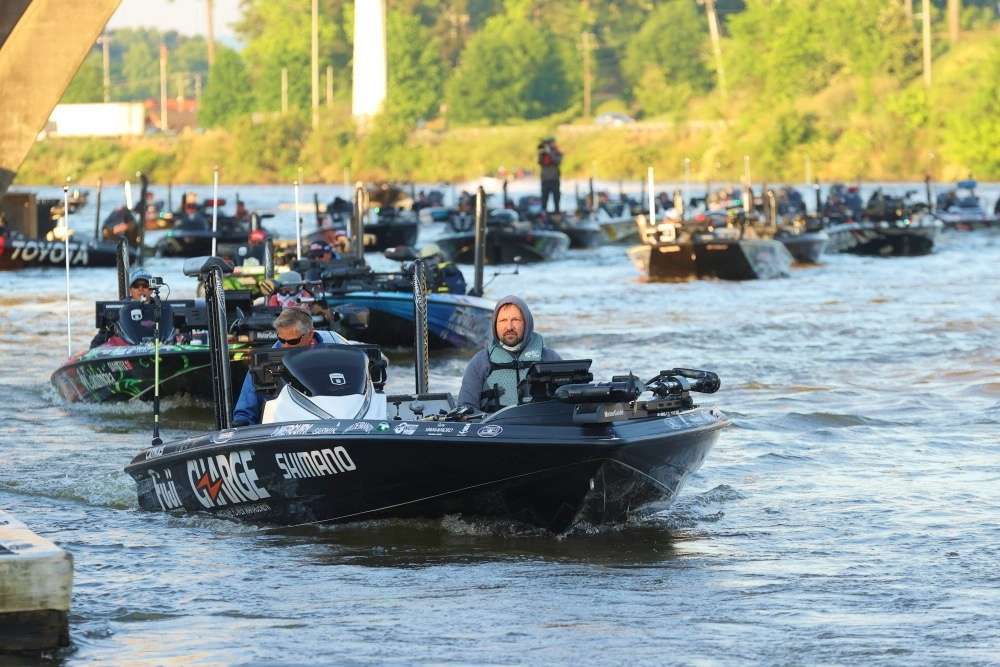
Ask any competitor on tournament day where they’d like to be in the takeoff order and “earlier the better” will normally be their response.
Competitive drive combined with the excitement and anticipation of the day ahead are what create that desire. That and the prospect of getting to the fish first, of course.
But should that always be the answer?
An obvious exception would be when the bite is better later in the day — like during early spring when warming temperatures get the bait and bass moving. Or perhaps when an angler’s game plan involves sight fishing. The higher the sun, the better the visibility.
Another possible advantage is that a later flight can translate to more time on the water. Here’s how. Because takeoff sequences often move so quickly, anglers leaving the dock last are afforded more time to fish. And that extra time can make a difference. Take our Bassmaster Elite Series events, for example. They send us in single file — one boat after another — yet our check-in times vary, usually 15 to 20 minutes apart. And they reverse that order on Day 2, so that everyone has the same amount of time to fish — at least in theory.
The only exception is after the Top 48 cut on Day 3, when there are two flights with separate departure and check-in times.
When haste makes waste
Too often, early draws are wasted.
I can recall numerous times in my career when an early draw got me nothing more than a faster start to a long, nonproductive day — situations when I didn’t have a good starting spot or any concentration of fish to run to.
That’s the way my luck seems to run — getting an early draw when I’m unable to take advantage of it. It’s like getting all dressed up with no place to go.
Even worse is getting an early draw, believing it’s going to pay off, then, for some reason, it doesn’t. Our recent Sabine River Elite event is a prime example. Although I was among the first to leave the dock on Day 1 of competition — believing I was going to score big at my starting spot — that spot yielded nothing.
I remember pulling in excited about the prospects of fishing what I thought was my best water only to end up with a string of undersized bass and a few mudfish. Talk about deflating. This was an event where the fish were concentrated in small areas, and I knew where those areas were.
I could have easily used that early draw to get to those places ahead of my fellow competitors. Instead, I foolishly chose to go in the opposite direction — to an area that proved worthless and effectively took me out of the race before it even started.

I can recall other similar situations, too — most of which were also self-inflicted. Too often, I place a premium on fishing less pressured water when the smarter choice would be to bump rails with my competition.
When it matters most
Early draws are perhaps most critical in one-day derbies — the kind many of you fish. In those events, there is no second day to reverse the takeoff order. It’s all or nothing on one day.
But are early draws really that critical … even in one-day competitions?
Occasionally you’ll hear of competitors who thought they were doomed by a late draw, yet ultimately went on to win the event. Although his challengers got out ahead of him, by weigh-in time, he (or she) ended up with the heaviest stringer.
The anglers who got out early probably thought they had the advantage. When they arrived at their best spots, however, they discovered they were void of fish. For whatever reason, they either swam away or just weren’t biting. So, an early draw meant nothing.
Meanwhile, the competitor who left the dock last probably figured he was taking leftovers, yet he lands on the mother lode and goes on to victory.
Yeah, this scenario doesn’t happen often, but it does happen … maybe more often than we realize.
When it pays
On those occasions when you have the right spot and draw a boat number to get you there first, then it’s only a matter of putting them in the boat. If you do, the rewards are huge.
The last time it happened for me was during the St. Lawrence River Elite. I drew out early in the first flight and arrived on my best waypoint with no one ahead of me. It was a small spot, yet it held a massive number of quality fish. And because it was small, I could easily defend it.
In less than two hours, I boated more than 20 bass — the biggest of which was nearly 6 pounds. Once I had better than a 4-pound average, I backed off and guarded the area. The next day, I lucked out and got there first again. And that day’s catch matched the first.
It also happened for me at Guntersville several years ago. It was during the spawn, and I had located a group of big fish bedding in one small area. I knew if I got there first, I’d be able to control things by simply sinking my Power-Poles … the beds were that close together.
As it turned out, I got the right draw, got there first, and in less than two hours, I boated more than 27 pounds of Lake Guntersville bass … and I never had to move the boat!
Follow Bernie Schultz on Facebook and through his website.

